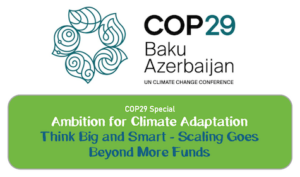COP29 is the ‚Finance COP‘ – Finance is Crucial to Scale the Ambitions of Climate Adaptation Efforts, But Scaling Positive Adaptation Outcomes Goes Way Beyond More Funding
by Martin Rokitzki, 11 November 2024
 CLIMATE ADAPTATION at SCALE – Think Big and Smart! New Paradigms are Needed!
CLIMATE ADAPTATION at SCALE – Think Big and Smart! New Paradigms are Needed!
How can and must higher levels of adaptation finance be linked to non-financial instruments and pathways to create an enhanced impact for more climate-vulnerable people?
COP29 is starting today in Baku (Azerbaijan). The focus is on increasing financial flows and setting a new global climate finance target (see also insights by WRI, Amnesty International, IISD, Grist).
There is no doubt that by the end of 2024, the world needs a serious boost in the scale of climate adaptation efforts. The IPCC identifies 3.3 to 3.6 billion; the World Bank sees 1.2 billion people facing life-changing risks through exposure to at least one critical climate hazard, such as heatwaves, flooding, hurricanes, and drought. No matter which exact definition we settle on, it is a significant portion of the world population.
While often being a nebulous and amorphous term, let’s define climate adaptation efforts here in view of livelihoods and ecosystem improvements in favor of people whose income sources and jobs; homes, schools and warehouses or good health is compromised by ever harsher climate impacts. A risk to people whose basic needs are not securely covered; lives that are significantly worsened by additional threats due floods, hurricanes, storm surges or droughts; families and households that have no or insufficient insurance, social safety nets or financial buffers and savings.
For too long, climate adaptation has been treated as an optional effort:
- that modifies previous approaches in incremental ways;
- that is financed by ‘surplus’ aid money (mostly in OECD countries) if available;
- that is boxed in ‘ill-conceived’ pilot projects that are unlikely to enhance sustainability or have an impact at scale.
Let’s make this the start of a decade that lays the ground for more substantial, structural, and comprehensive climate adaptation.
What Do Scaling Processes Look Like?
Let’s talk about scale! There are three types of scaling concepts (see figures 1 to 4) that tend to dominate the existing approaches (Riddell et al. 2015, Moore et al. 2015):
- Scaling-Up consists of shifting the laws and policies of systems in order to either remove oppressive precepts, or to introduce game-changing rules that will bring social benefit to large numbers of people;
- Scaling-Out is about growing or replicating a solution to other geographic areas, including lateral scaling to new target populations; and
- Scaling-Deep involves actions intended to promote transformation at the sociocultural level of individuals, organizations or communities (Fraser 2023).
These three conceptual models of scaling are not exhaustive and there are additional ways to think about scale (Seelos et al. 2017).
Too many adaptation-focused projects, programs and investments look(ed) at scaling from an over-cautious and narrow perspective: ‘let’s start small, i.e. pilot projects, incremental changes to the business-as-usual… test and experiment…and hope that the technology, management practices or systems established grows and scales’. The Adaptation Fund, for instance, assumes scaling adaptation interventions ‘by increasing the impact of climate change adaptation innovations, policies, programmes, and projects successfully tested in pilots by extending their outreach to more people, in different places over time, and ensuring this deliberate expansion is done sustainably by adapting to local context and fostering policy change and programme development on a lasting basis.’ (AF 2022).
This approach (Woltering et al. 2019) isn’t sufficient anymore; adaptation challenges are too serious and pressing to be treated through an outdated and ‘play-it-safe’ paradigm.
The World Bank recently stated in its Rising to the Challenge report (2024) that many studies note that adaptation action remains fragmented, local and incremental, with limited evidence of transformational adaptation and risk reductions (Berrang-Ford et al. 2021). The World Bank Adaptation & Resilience readiness assessments confirm this finding and conclude that countries have made least progress in addressing macro-fiscal issues highlighting the technical and capacity challenges to identify, quantify, and manage macro-fiscal risks posed by climate impacts, including risks to macroeconomic stability, public finances, debt sustainability, and the financial sector.
Furthermore, a more rigorous investigation is required into integrating climate risks into investment policies (see OECD Climate Adaptation Investment Framework, UNEP Adaptation Gap Report 2024, Climate Bonds Resilience Taxonomy), new public and private (Martin et al. 2024) accounting and valuation mechanisms, and discount rates (ADB 2015).
In an upcoming series of blogs, PlanAdapt will (1) elaborate on the interconnections between scaling, adaptation impact and innovation; (2) outline how scaling ’happens’ and discuss related scaling pathways, using financial and non-financial instruments (3). We will continue to showcase aspects that relate to the planning and management of scaling processes (4), before outlining the role of evidence and learning, including monitoring and evaluation (5). Eventually, we will highlight the roles, types and characteristics of a range of actors in scaling processes (6).
All the best to the hard-working colleagues who seek to enhance the level of ambition for inclusive, effective and equitable climate adaptation in Baku!
Read more about related PlanAdapt initiatives:

